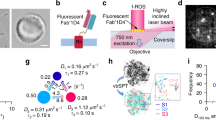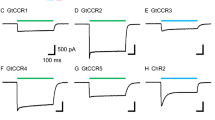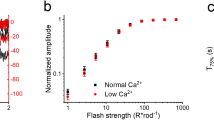Abstract
The assembly of signalling molecules into macromolecular complexes (transducisomes) provides specificity, sensitivity and speed in intracellular signalling pathways1,2. Rod photoreceptors in the eye contain an unusual set of glutamic-acid-rich proteins (GARPs) of unknown function3,4,5,6,7. GARPs exist as two soluble forms, GARP1 and GARP2, and as a large cytoplasmic domain (GARP′ part) of the β-subunit of the cyclic GMP-gated channel3,4,5,6,7. Here we identify GARPs as multivalent proteins that interact with the keyplayers of cGMP signalling, phosphodiesterase and guanylate cyclase, and with a retina-specific ATP-binding cassette transporter (ABCR)8,9, through four, short, repetitive sequences. In electron micrographs, GARPs are restricted to the rim region and incisures of discs in close proximity to the guanylate cyclase and ABCR, whereas the phosphodiesterase is randomly distributed. GARP2, the most abundant splice form, associates more strongly with light-activated than with inactive phosphodiesterase, and GARP2 potently inhibits phosphodiesterase activity. Thus, the GARPs organize a dynamic protein complex near the disc rim that may control cGMP turnover and possibly other light-dependent processes. Because there are no similar GARPs in cones, we propose that GARPs may prevent unnecessary cGMP turnover during daylight, when rods are held in saturation by the relatively high light levels.
This is a preview of subscription content, access via your institution
Access options
Subscribe to this journal
Receive 51 print issues and online access
$199.00 per year
only $3.90 per issue
Buy this article
- Purchase on Springer Link
- Instant access to full article PDF
Prices may be subject to local taxes which are calculated during checkout





Similar content being viewed by others
References
Tsunoda, S. et al. Amultivalent PDZ-domain protein assembles signalling complexes in a G-protein-coupled cascade. Nature 388, 243–249 (1997).
Zuker, C. S. & Ranganathan, R. The path to specificity. Science 283, 650–651 (1999).
Sugimoto, Y., Yatsunami, K., Tsujimoto, M., Khorana, H. G. & Ichikawa, A. The amino acid sequence of a glutamic acid-rich protein from bovine retina as deduced from the cDNA sequence. Proc. Natl Acad. Sci. USA 88, 3116–3119 (1991).
Körschen, H. G. et al. A240 kDa protein represents the complete β subunit of the cyclic nucleotide-gated channel from rod photoreceptor. Neuron 15, 627–636 (1995).
Ardell, M. D. et al. cDNA, gene structure, and chromosomal localization of human GAR1 (CNCG3L), a homolog of the third subunit of bovine photoreceptor cGMP-gated channel. Genomics 28, 32–38 (1995).
Colville, C. A. & Molday, R. S. Primary structure and expression of the human β-subunit and related proteins of the rod photoreceptor cGMP-gated channel. J. Biol. Chem. 271, 32968–32974 (1996).
Grunwald, M. E., Yu, W.-P., Yu, H.-H. & Yau, K.-W. Identification of a domain on the β-subunit of the rod cGMP-gated cation channel that mediates inhibition by calcium–calmodulin. J. Biol. Chem. 273, 9148–9157 (1998).
Illing, M., Molday, L. L. & Molday, R. S. The 220-kDa rim protein of retinal rod outer segment is a member of the ABC transporter superfamily. J. Biol. Chem. 272, 10303–10310 (1997).
Allikmets, R. et al. Aphotoreceptor cell-specific ATP-binding transporter gene (ABCR) is mutated in recessive Stargardt macular dystrophy. Nature Genet. 15, 236–246 (1997).
Papermaster, D. S., Schneider, B. G., Zorn, M. A. & Kraehenbuhl, J. P. Immunocytochemical localization of a large intrinsic membrane protein to the incisures and margins of frog rod outer segment disks. J. Cell Biol. 78, 415–425 (1978).
Montell, C. TRP trapped in fly signaling web. Curr. Opin. Neurobiol. 8, 389–397 (1998).
Koch, K.-W. & Lambrecht, H.-G. in Signal Transduction in Photoreceptor Cells (eds Hargrave, P. A., Hofmann, K. P. & Kaupp, U. B.) 259–267 (Springer, Berlin, (1992).
Schrem, A., Lange, C., Beyermann, M. & Koch, K.-W. Identification of a domain in guanylyl cyclase-activating protein 1 that interacts with a complex of guanylyl cyclase and tubulin in photoreceptors. J.Biol. Chem. 274, 6244–6249 (1999).
Heck, M. & Hofmann, K. P. G-protein-effector coupling: A real-time light-scattering assay for transducin-phosphodiesterase interaction. Biochemistry 32, 8220–8227 (1993).
Liu, X. et al. Ultrastructural localization of retinal guanylate cyclase in human and monkey retinas. Exp. Eye Res. 59, 761–768 (1994).
Cook, N. J., Molday, L. L., Reid, D., Kaupp, U. B. & Molday, R. S. The cGMP-gated channel of bovine rod photoreceptors is localized exclusively in the plasma membrane. J. Biol. Chem. 264, 6996–6999 (1989).
Pedler, C. M. & Tilly, R. The fine structure of photoreceptor discs. Vision Res. 7, 829–836 (1967).
Eckmiller, M. S. & Toman, A. Association of kinesin with microtubules in diverse cytoskeletal systems in the outer segments of rods and cones. Acta Anat. 162, 133–141 (1998).
Roof, D. J. & Heuser, J. E. Surfaces of rod photoreceptor disk membranes: Integral membrane components. J. Cell Biol. 95, 487–500 (1982).
He, W., Cowan, C. W. & Wensel, T. G. RGS9, a GTPase accelerator for phototransduction. Neuron 20, 95–102 (1998).
Makino, E. R., Handy, J. W., Li, T. & Arshavsky, V. Y. The GTPase activating factor for transducin in rod photoreceptors is the complex between RGS9 and type 5 G protein β subunit. Proc. Natl Acad. Sci. USA 96, 1947–1952 (1999).
Pugh, E. N. J & Lamb, T. D. Amplification and kinetics of the activation steps in phototransduction. Biochim. Biophys. Acta 1141, 111–149 (1993).
Bönigk, W. et al. Rod and cone photoreceptor cells express distinct genes for cGMP-gated channels. Neuron 10, 865–877 (1993).
Zoche, M., Bienert, M., Beyermann, M. & Koch, K.-W. Distinct molecular recognition of calmodulin-binding sites in the neuronal and macrophage nitric oxide synthases: A surface plasmon resonance study. Biochemistry 35, 8742–8747 (1996).
Hsu, Y.-T. & Molday, R. S. Modulation of the cGMP-gated channel of rod photoreceptor cells by calmodulin. Nature 361, 76–79 (1993).
Lambrecht, H.-G. & Koch, K.-W. A26 kd calcium binding protein from bovine rod outer segments as modulator of photoreceptor guanylate cyclase. EMBO J. 10, 793–798 (1991).
Wolfrum, U. Centrin in the photoreceptor cells of mammalian retinae. Cell Motil. Cytoskel. 32, 55–64 (1995).
Wolfrum, U., Liu, X., Schmitt, A., Udovichenko, I. P. & Williams, D. S. Myosin VIIa as a common component of cilia and microvilli. Cell Motil. Cytoskel. 40, 261–271 (1998).
Danscher, G. Localization of gold in biological tissue. A photochemical method for light and electron microscopy. Histochemistry 71, 81–88 (1981).
Acknowledgements
We thank J. Beavo, J. Nathans, I. Weyand and D. Weitz for antibodies, A. Eckert forpreparing the manuscript, I. Weyand and R. Seifert for critical reading of the manuscript, and E. Pugh and R. Cote for discussions. This work was supported by grants from the EU (U.B.K.), the Deutsche Forschungsgemeinschaft (M.B., K.P.H., K.-W.K., U.B.K., U.W.) and the FAUN-Stiftung (U.W.).
Author information
Authors and Affiliations
Corresponding author
Rights and permissions
About this article
Cite this article
Körschen, H., Beyermann, M., Müller, F. et al. Interaction of glutamic-acid-rich proteins with the cGMP signalling pathway in rod photoreceptors. Nature 400, 761–766 (1999). https://doi.org/10.1038/23468
Received:
Accepted:
Issue Date:
DOI: https://doi.org/10.1038/23468
This article is cited by
-
The structure of the native CNGA1/CNGB1 CNG channel from bovine retinal rods
Nature Structural & Molecular Biology (2022)
-
Mechanistic insights into the role of prenyl-binding protein PrBP/δ in membrane dissociation of phosphodiesterase 6
Nature Communications (2018)
-
An equation to estimate the difference between theoretically predicted and SDS PAGE-displayed molecular weights for an acidic peptide
Scientific Reports (2015)
-
Overexpression of rod photoreceptor glutamic acid rich protein 2 (GARP2) increases gain and slows recovery in mouse retina
Cell Communication and Signaling (2014)
-
Age-related changes in Cngb1-X1 knockout mice: prolonged cone survival
Documenta Ophthalmologica (2012)
Comments
By submitting a comment you agree to abide by our Terms and Community Guidelines. If you find something abusive or that does not comply with our terms or guidelines please flag it as inappropriate.



